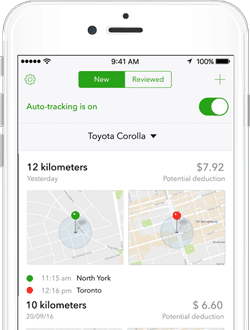How to Keep a Mileage Log
Whether you own a small business or self-employed, you can keep a logbook by jotting down all the relevant information in a paper notebook or saving it in a word processing file, but it's easier to use a mileage tracker app to streamline the record-keeping process.
Remember the CRA requires you to keep all business records for at least six years, and that rule also applies to logbooks or data from a mileage tracker app. If you get audited, those details can be essential.
The documentation needed to track mileage includes:
- Your business, commuting, and personal miles
- The business purpose related to the deductible drive
- The mileage (number of kilometres) for each deductible trip
- Dates of your deductible drives, the start location and the destination
To make mileage logging easier for small business owners, the CRA also offers a simplified system. With this system, you must track every single kilometre you drive for work during the first year you use the vehicle for business. That’s considered your base year. You also need to be able to show the percentage you drove the vehicle for business in every quarter of the first year.
In the second year, you need to track your miles for a three-month sample period. To make the process as easy as possible, consider doing this during the first three months of the tax year. During this period, track your total mileage as well as the driving you do for your business. Then, calculate the percentage of the time you used your vehicle for work, and compare that number to the percentage of time you used the vehicle for work during the base year.
To explain, say you used the vehicle for work 40% of the time in the base year. During each quarter, your business usage was as follows: 33%, 45%, 47%, and 35%. During the first three months of the second year, you drove 8,000 kilometres in total and logged 4,000 kilometres for business purposes. This means you use your vehicle 50% of the time for business purposes. At this point, you need to plug those numbers into the following equation:
- (Sample Year Period % / Base Year Period %) x Base Year Annual Percentage = Calculate Annual Business Use
Because you used the first quarter of the year as your sample year period, you also need to use the first quarter of the last year as your base year period. As a result, the equation becomes (50% / 33%) x 40% = 61%.
Once you have that number, compare it to the percentage for your base year. If the number is within 10 points, you can use that figure as your annual percentage. In this situation, you used the vehicle 40% of the time for business during the base year and calculated 61% as your potential annual business use percentage.
Because the number is more than 10 points away from your base year percentage, you cannot use the simplified system. You have to manually track the numbers for the rest of the year. But, here’s the good news: You can use your second year as a base year and try to move to the simplified system in your third year of business.
On the other hand, if you did all the above calculations and your number is between 30% and 50%, or 10 points lower and 10 points higher than the percentage you used in your base year, you’re allowed to use the simplified system.
If you qualify to use the simplified system, you only have to keep a detailed logbook for the sample quarter as explained above. Then, you just multiply all your allowable vehicle expenses by the simplified percentage. For instance, if you’re using 45% as your simplified percentage, you multiply your expenses by 45%.
Learn how to accurately document your expenses with confidence by reading our guide to expenses.



